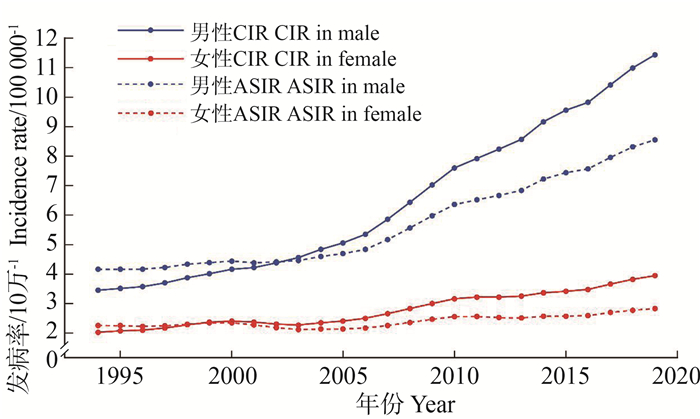Age-period-cohort analysis of incidence and mortality trends of nasopharyngeal carcinoma in the Chinese population, 1994-2019
-
摘要:
目的 了解中国人群鼻咽癌发病率及死亡率的流行趋势,评估不同年龄、时期、出生队列对鼻咽癌发病及死亡风险的影响。 方法 通过全球健康数据交换库获得1994–2019年中国不同性别人群的鼻咽癌发病及死亡数据,描述鼻咽癌发病率与死亡率的时间变化趋势,并基于年龄-时期-队列(age-period-cohort, APC)模型和内生因子法估算鼻咽癌发病及死亡的年龄效应、时期效应、队列效应。 结果 1994–2019年,中国男性与女性鼻咽癌年龄标准化发病率分别从1994年4.16/10万、2.26/10万增至2019年8.55/10万、2.83/10万,男性与女性鼻咽癌年龄标准化死亡率分别从1994年3.57/10万、1.80/10万降至2019年2.20/10万、0.72/10万。APC模型分析结果显示,1994–2019年,中国男性与女性鼻咽癌发病的年龄效应均随年龄增加先升高后降低再升高[效应系数(男性):-1.94~0.68~0.18~0.54,均P < 0.05;效应系数(女性):-1.49~0.49~0.20~0.38,均P < 0.05],时期效应随年份增加呈现升高的趋势[效应系数(男性):-0.44~0.53,均P < 0.05;效应系数(女性):-0.12~0.24,均P < 0.05],队列效应随出生队列推移呈现先降低后升高再降低的趋势[效应系数(男性):0.82~-0.36~-0.05~-0.36,均P < 0.05;效应系数(女性):0.63~-0.17~-0.01~-0.57,均P < 0.05];中国男性与女性鼻咽癌死亡的年龄效应均随年龄增加呈现上升趋势[效应系数(男性):-2.08~1.04,均P < 0.05;效应系数(女性):-1.75~1.08,均P < 0.05],男性鼻咽癌死亡的队列效应随出生队列推移而逐渐降低(效应系数:0.95~-0.89,P < 0.05),但未观察到我国鼻咽癌死亡率存在明显的时期效应,同时女性鼻咽癌死亡的队列效应也不明显。 结论 中国男性与女性鼻咽癌发病风险均不同程度地受年龄效应、时期效应及队列效应的影响,男性鼻咽癌死亡风险受年龄效应、队列效应的影响,而女性鼻咽癌死亡风险仅受年龄效应的影响。建议加强40岁以上人群尤其男性群体的鼻咽癌健康宣教、早期癌症筛查工作以降低我国鼻咽癌发病与死亡风险。 -
关键词:
- 鼻咽癌 /
- 发病率 /
- 死亡率 /
- 年龄-时期-队列模型
Abstract:Objective To understand the incidence and mortality trends of nasopharyngeal carcinoma among the Chinese population, and to evaluate the effect of age, period and birth cohort on the risk of nasopharyngeal carcinoma incidence and mortality. Methods Data on gender-specific incidence and mortality of nasopharyngeal carcinoma among the Chinese population between 1994 to 2014 were obtained through the Global Health Data Exchange Database. We described the temporal trend of nasopharyngeal carcinoma incidence and mortality, and the age effect, period effect, and cohort effect were estimated using an age-period-cohort (APC) model and intrinsic estimator method. Results The standardized incidence of nasopharyngeal carcinoma among Chinese male and female population increased from 4.16/100 000 and 2.26/100 000 in 1994 to 8.55/100 000 and 2.83/100 000 in 2019, while the standardized mortality of nasopharyngeal carcinoma decreased from 3.57/100 000 and 1.80/100 000 in 1994 to 2.20/100 000 and 0.72/100 000 in 2019. Results of APC analysis showed that during 1994-2019, age effect of nasopharyngeal carcinoma incidence in both Chinese male and female population increased first, then decreased and increased afterward with the increase of age [effect coefficient (male): -1.94-0.68 to 0.18-0.54, all P < 0.05; effect coefficient (female): -1.49-0.49 to 0.20-0.38, all P < 0.05]; period effect showed an increasing trend as year increased [effect coefficient (male): -0.44-0.53, all P < 0.05; effect coefficient (female): -0.12-0.24, all P < 0.05]; cohort effect decreased first, then increased and then decreased with the year of birth [effect coefficient (male): 0.82--0.36 to-0.05--0.36, all P < 0.05; effect coefficient (female): 0.63--0.17 to-0.01--0.57, all P < 0.05]. Age effect of nasopharyngeal carcinoma mortality in Chinese population exhibited an upward trend with the increase of age [effect coefficient (male): -2.08-1.04, all P < 0.05; effect coefficient (female): -1.75-1.08, all P < 0.05]; cohort effect of nasopharyngeal carcinoma mortality among Chinese male population decreased with year of birth (effect coefficient: 0.95--0.89, P < 0.05). However, significant period effect of nasopharyngeal carcinoma mortality in the whole population and cohort effect of nasopharyngeal carcinoma mortality among Chinese female population were not observed. Conclusions Age effect exerts impacts on the risk of nasopharyngeal carcinoma incidence in both Chinese male and female population to varying degrees. The risk of nasopharyngeal carcinoma mortality among Chinese male population is affected by age effect and cohort effect, while the risk of nasopharyngeal carcinoma mortality in Chinese female population is only affected by age effect. Health education and screening for nasopharyngeal cancer are suggested to be strengthened for individuals aged over 40 years, especially for males to reduce the risk of nasopharyngeal carcinoma incidence and mortality. -
Key words:
- Nasopharyngeal carcinoma /
- Incidence /
- Mortality /
- Age-period-cohort model
-
表 1 1994–2019年中国男性与女性鼻咽癌发病率APC模型分析结果
Table 1. Results of APC model analysis on nasopharyngeal carcinoma incidence in Chinese males and females from 1994 to 2019
变量 Variable 男性Male 女性Female 效应系数
CoefSE 95% CI P值
value效应系数
CoefSE 95% CI P值
value年龄组/岁 Age group/years 20~ < 25 -1.94 0.38 -2.70~-1.19 < 0.001 ① -1.49 0.46 -2.40~-0.58 0.001 ① 25~ < 30 -1.50 0.28 -2.05~-0.94 < 0.001 ① -1.09 0.35 -1.78~-0.40 0.002 ① 30~ < 35 -0.70 0.21 -1.10~-0.29 0.001 ① -0.49 0.27 -1.03~0.04 0.072 35~ < 40 -0.20 0.18 -0.55~0.15 0.255 -0.20 0.25 -0.68~0.28 0.422 40~ < 45 0.25 0.16 -0.06~0.55 0.114 0.12 0.22 -0.32~0.55 0.599 45~ < 50 0.45 0.15 0.17~0.73 0.002 ① 0.27 0.21 -0.14~0.68 0.193 50~ < 55 0.56 0.14 0.29~0.82 < 0.001 ① 0.39 0.20 -0.01~0.78 0.054 55~ < 60 0.68 0.12 0.43~0.92 < 0.001 ① 0.49 0.19 0.12~0.86 0.010 ① 60~ < 65 0.59 0.12 0.36~0.82 < 0.001 ① 0.49 0.18 0.14~0.84 0.007 ① 65~ < 70 0.52 0.11 0.30~0.74 < 0.001 ① 0.36 0.18 0.00~0.71 0.047 ① 70~ < 75 0.36 0.11 0.15~0.58 0.001 ① 0.33 0.17 -0.01~0.67 0.058 75~ < 80 0.21 0.11 -0.01~0.42 0.059 0.25 0.17 -0.09~0.59 0.145 80~ < 85 0.18 0.11 -0.03~0.39 0.094 0.20 0.17 -0.14~0.54 0.256 85~ < 90 0.54 0.11 0.33~0.75 < 0.001 ① 0.38 0.18 0.03~0.73 0.033 ① 时期/年 Period/year 1994 -0.44 0.09 -0.62~-0.26 < 0.001 ① -0.12 0.12 -0.37~0.12 0.328 1999 -0.30 0.08 -0.46~-0.14 < 0.001 ① -0.11 0.12 -0.34~0.13 0.373 2004 -0.21 0.08 -0.37~-0.06 0.008 ① -0.13 0.12 -0.37~0.11 0.279 2009 0.08 0.07 -0.06~0.23 0.278 0.01 0.12 -0.22~0.24 0.910 2014 0.34 0.07 0.20~0.48 < 0.001 ① 0.11 0.11 -0.12~0.33 0.352 2019 0.53 0.07 0.39~0.66 < 0.001 ① 0.24 0.11 0.02~0.46 0.034 ① 队列/年 Cohort/year 1905–1909 0.82 0.22 0.38~1.26 < 0.001 ① 0.63 0.34 -0.04~1.30 0.067 1910–1914 0.73 0.17 0.39~1.07 < 0.001 ① 0.56 0.26 0.05~1.07 0.031 ① 1915–1919 0.46 0.16 0.16~0.77 0.003 ① 0.42 0.23 -0.02~0.87 0.063 1920–1924 0.35 0.13 0.09~0.61 0.008 ① 0.30 0.20 -0.10~0.70 0.144 1925–1929 0.28 0.12 0.05~0.51 0.016 ① 0.21 0.19 -0.16~0.58 0.273 1930–1934 0.17 0.11 -0.04~0.38 0.115 0.11 0.18 -0.24~0.45 0.550 1935–1939 -0.01 0.12 -0.24~0.23 0.961 -0.05 0.20 -0.43~0.33 0.788 1940–1944 -0.13 0.13 -0.39~0.12 0.305 -0.16 0.21 -0.57~0.25 0.448 1945–1949 -0.21 0.14 -0.48~0.06 0.128 -0.13 0.21 -0.55~0.29 0.556 1950–1954 -0.29 0.15 -0.58~-0.01 0.045 ① -0.12 0.22 -0.55~0.32 0.598 1955–1959 -0.36 0.16 -0.67~-0.06 0.021 ① -0.17 0.24 -0.63~0.29 0.466 1960–1964 -0.36 0.17 -0.69~-0.03 0.030 ① -0.13 0.25 -0.61~0.35 0.586 1965–1969 -0.31 0.18 -0.65~0.04 0.085 -0.10 0.26 -0.61~0.40 0.689 1970–1974 -0.27 0.19 -0.63~0.10 0.157 -0.07 0.27 -0.60~0.46 0.801 1975–1979 -0.17 0.20 -0.57~0.23 0.401 -0.01 0.30 -0.59~0.57 0.973 1980–1984 -0.05 0.23 -0.51~0.40 0.814 -0.04 0.35 -0.73~0.64 0.902 1985–1989 -0.05 0.29 -0.62~0.52 0.864 -0.22 0.45 -1.10~0.67 0.633 1990–1994 -0.24 0.45 -1.12~0.64 0.597 -0.45 0.69 -1.80~0.89 0.509 1995–1999 -0.36 0.83 -1.98~1.26 0.664 -0.57 1.25 -3.02~1.88 0.648 AIC 5.00 4.15 BIC -206.18 -210.74 注:APC, 年龄-时期-队列模型; AIC, 赤池信息准则; BIC, 贝叶斯信息准则。
① P<0.05。
Note: APC, age-period-cohort model; AIC, Akaike information criterion; BIC, Bayesian information criterion.
① P<0.05.表 2 1994–2019年中国男性与女性鼻咽癌死亡率APC模型分析结果
Table 2. Results of APC model analysis on nasopharyngeal carcinoma mortality in Chinese males and females from 1994 to 2019
变量 Variable 男性 Male 女性 Female 效应系数
CoefSE 95% CI P值
value效应系数
CoefSE 95% CI P值
value年龄组/岁 Age group/years 20~ < 25 -2.08 0.74 -3.53~-0.63 0.005 ① -1.75 0.97 -3.65~0.15 0.071 25~ < 30 -1.84 0.60 -3.02~-0.67 0.002 ① -1.43 0.76 -2.92~0.06 0.060 30~ < 35 -1.17 0.44 -2.04~-0.30 0.008 ① -1.04 0.62 -2.26~0.19 0.097 35~ < 40 -0.66 0.36 -1.36~0.04 0.063 -0.68 0.52 -1.69~0.34 0.192 40~ < 45 -0.10 0.28 -0.65~0.46 0.731 -0.30 0.43 -1.14~0.54 0.483 45~ < 50 0.13 0.25 -0.36~0.61 0.612 -0.07 0.37 -0.80~0.66 0.845 50~ < 55 0.36 0.21 -0.06~0.78 0.094 0.16 0.32 -0.48~0.79 0.628 55~ < 60 0.59 0.18 0.23~0.94 0.001 ① 0.31 0.28 -0.25~0.86 0.281 60~ < 65 0.62 0.16 0.30~0.94 < 0.001 ① 0.49 0.25 0.00~0.98 0.050 65~ < 70 0.71 0.15 0.42~1.00 < 0.001 ① 0.56 0.23 0.10~1.02 0.017 ① 70~ < 75 0.79 0.14 0.51~1.06 < 0.001 ① 0.80 0.22 0.37~1.24 < 0.001 ① 75~ < 80 0.76 0.15 0.46~1.05 < 0.001 ① 0.90 0.24 0.44~1.36 < 0.001 ① 80~ < 85 0.88 0.16 0.56~1.20 < 0.001 ① 0.97 0.26 0.45~1.49 < 0.001 ① 85~ < 90 1.04 0.19 0.66~1.41 < 0.001 ① 1.08 0.31 0.47~1.69 0.001 ① 时期/年 Period/year 1994 0.02 0.13 -0.23~0.27 0.873 0.35 0.18 -0.01~0.70 0.058 1999 0.08 0.10 -0.12~0.27 0.443 0.22 0.15 -0.08~0.51 0.151 2004 -0.02 0.09 -0.20~0.17 0.869 0.04 0.14 -0.25~0.32 0.799 2009 -0.05 0.10 -0.25~0.14 0.595 -0.14 0.16 -0.45~0.17 0.385 2014 -0.02 0.11 -0.24~0.19 0.829 -0.23 0.18 -0.58~0.12 0.205 2019 -0.01 0.13 -0.25~0.24 0.967 -0.23 0.21 -0.64~0.17 0.259 队列/年 Cohort/year 1905–1909 0.95 0.29 0.39~1.51 0.001 ① 0.65 0.43 -0.20~1.50 0.132 1910–1914 0.78 0.23 0.33~1.23 0.001 ① 0.58 0.35 -0.10~1.26 0.095 1915–1919 0.53 0.20 0.13~0.92 0.009 ① 0.48 0.30 -0.11~1.07 0.112 1920–1924 0.44 0.18 0.09~0.80 0.014 ① 0.42 0.27 -0.12~0.96 0.126 1925–1929 0.41 0.17 0.08~0.74 0.014 ① 0.42 0.26 -0.09~0.94 0.106 1930–1934 0.37 0.16 0.05~0.69 0.023 ① 0.40 0.26 -0.11~0.91 0.121 1935–1939 0.31 0.18 -0.04~0.66 0.081 0.38 0.29 -0.19~0.94 0.192 1940–1944 0.24 0.20 -0.16~0.64 0.237 0.32 0.32 -0.32~0.95 0.332 1945–1949 0.16 0.23 -0.28~0.61 0.475 0.32 0.36 -0.39~1.03 0.380 1950–1954 0.05 0.26 -0.46~0.56 0.855 0.26 0.41 -0.55~1.06 0.533 1955–1959 -0.09 0.29 -0.67~0.49 0.757 0.08 0.47 -0.84~0.99 0.872 1960–1964 -0.20 0.33 -0.85~0.45 0.554 -0.03 0.52 -1.06~1.00 0.958 1965–1969 -0.27 0.37 -1.00~0.46 0.470 -0.14 0.58 -1.29~1.00 0.807 1970–1974 -0.39 0.42 -1.21~0.43 0.354 -0.28 0.65 -1.56~0.99 0.663 1975–1979 -0.46 0.49 -1.43~0.51 0.356 -0.40 0.79 -1.94~1.15 0.614 1980–1984 -0.51 0.62 -1.73~0.72 0.417 -0.59 1.02 -2.60~1.42 0.565 1985–1989 -0.66 0.85 -2.33~1.01 0.441 -0.85 1.43 -3.66~1.95 0.551 1990–1994 -0.79 1.25 -3.24~1.66 0.529 -0.99 2.01 -4.94~2.96 0.622 1995–1999 -0.89 2.20 -5.22~3.43 0.685 -1.01 3.50 -7.88~5.85 0.773 AIC 4.21 3.41 BIC -211.20 -212.02 注:APC,年龄-时期-队列模型; AIC,赤池信息准则;BIC,贝叶斯信息准则。
① P<0.05。
Note: APC, age-period-cohort model; AIC, Akaike information criterion; BIC, Bayesian information criterion.
① P<0.05. -
[1] Chen YP, Chan ATC, Le QT, et al. Nasopharyngeal carcinoma[J]. Lancet, 2019, 394(10192): 64-80. DOI: 10.1016/S0140-6736(19)30956-0. [2] Torre LA, Bray F, Siegel RL, et al. Global cancer statistics, 2012[J]. CA Cancer J Clin, 2015, 65(2): 87-108. DOI: 10.3322/caac.21262. [3] Chang ET, Adami HO. The enigmatic epidemiology of nasopharyngeal carcinoma[J]. Cancer Epidemiol Biomarkers Prev, 2006, 15(10): 1765-1777. DOI: 10.1158/1055-9965.EPI-06-0353. [4] Yin DP, Zheng YF, Sun P, et al. The pro-tumorigenic activity of p38γ overexpression in nasopharyngeal carcinoma[J]. Cell Death Dis, 2022, 13(3): 210. DOI: 10.1038/s41419-022-04637-8. [5] Bai R, Sun J, Xu Y, et al. Incidence and mortality trends of nasopharynx cancer from 1990 to 2019 in China: an age-period-cohort analysis[J]. BMC Public Health, 2022, 22(1): 1351. DOI: 10.1186/s12889-022-13688-7. [6] GBD 2017 Causes of Death Collaborators. Global, regional, and national age-sex-specific mortality for 282 causes of death in 195 countries and territories, 1980-2017: a systematic analysis for the Global Burden of Disease Study 2017[J]. Lancet, 2018, 392(10159): 1736-1788. DOI: 10.1016/S0140-6736(18)32203-7. [7] Stevens GA, Alkema L, Black RE, et al. Guidelines for Accurate and Transparent Health Estimates Reporting: the GATHER statement[J]. Lancet, 2016, 388(10062): e19-e23. DOI: 10.1016/S0140-6736(16)30388-9.Z. [8] 雷林, 尚庆刚, 刘维耿, 等. 2001-2015年深圳市鼻咽癌流行现况和时间趋势[J]. 中华肿瘤防治杂志, 2019, 26(20): 1499-1503. DOI: 10.16073/j.cnki.cjcpt.2019.20.02.Lei L, Shang QG, Liu WG, et al. Incidences and epidemiologic trends of nasopharyngeal cancer in Shenzhen, 2001-2015[J]. Chin J Cancer Prev Treat, 2019, 26(20): 1499-1503. DOI: 10.16073/j.cnki.cjcpt.2019.20.02. [9] 张小鹏, 李秋捷, 边枫, 等. 110例鼻咽癌患者预后因素及生存分析[J]. 中国耳鼻咽喉颅底外科杂志, 2014, 20(6): 507-511. DOI: 10.11798/j.issn.1007-1520.201406010.Zhang XP, Li QJ, Bian F, et al. Analysis of survival rates and prognostic factors in 110 patients with nasopharyngeal carcinoma[J]. Chin J Otorhinolaryngol Skull Base Surg, 2014, 20(6): 507-511. DOI: 10.11798/j.issn.1007-1520.201406010. [10] Wu CY, Lin YH, Lo WC, et al. Nutritional status at diagnosis is prognostic for pharyngeal cancer patients: a retrospective study[J]. Eur Arch Otorhinolaryngol, 2022, 279(7): 3671-3678. DOI: 10.1007/s00405-021-07222-5. [11] Yang L, Xue Y, Wei Z, et al. Local radiotherapy versus nonradiotherapy to distant lesions for metastatic nasopharyngeal carcinoma: Retrospective cohort study[J]. Head Neck, 2022, 44(3): 615-623. DOI: 10.1002/hed.26953. [12] Xie SH, Yu IT, Tse LA, et al. Occupational risk factors for nasopharyngeal carcinoma in Hong Kong Chinese: a case-referent study[J]. Int Arch Occup Environ Health, 2017, 90(5): 443-449. DOI: 10.1007/s00420-017-1212-4. [13] 曹方政. 医疗保险制度的中日比较研究[D]. 长春: 吉林大学, 2017.Cao FZ. A Comparative Study on the Medical Insurance Systems in China and Japan[D]. Changchun: Jilin University, 2017. -





 下载:
下载:






